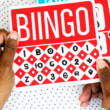When a player in bingo places a particular number in the bingo card, they are claiming a particular row or column on the bingo board. The numbers 1-49 are in one column, 50-99 are in another column, and 100-199 are in a third column.
Bingo markers placed in any of these designated rows or columns light up when called.
When a player claims a particular row or column by placing a bingo marker in it, they are saying “I have the number associated with this row or column.” If the next player has the same number as what was claimed, then that player can say “Bingo!” and win the game.
If the next player has a different number, then that player can say “Bingo!” and win the game if they happen to be playing with an empty card. .
If no one has claimed a particular row or column when bingo is called, then the next row or column is available for play.
The postage stamp in bingo is represented by the number 26. This is because 26 is both the second letter of the alphabet (a) and the sixth number in order (6).
When players claim a particular row or column with their bingo markers, they are saying “I have the number associated with this row or column.” If no one has claimed that row or column when bingo is called, then players can start playing from the next available row or column.








